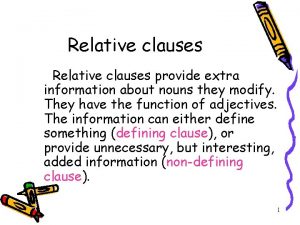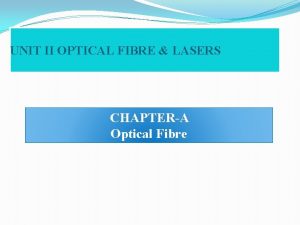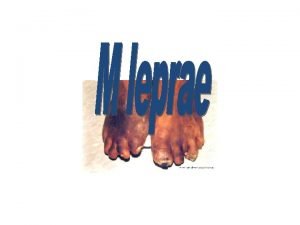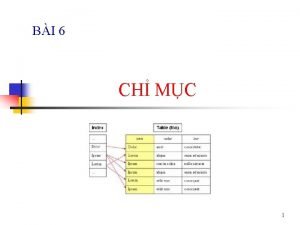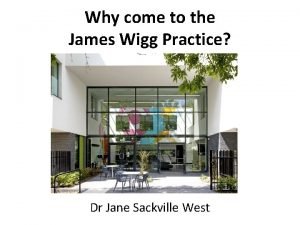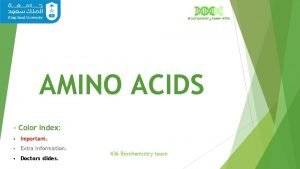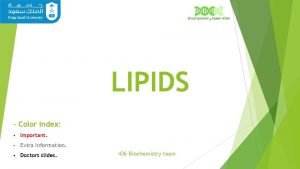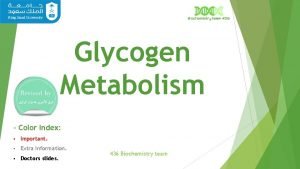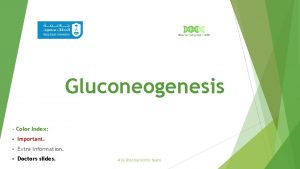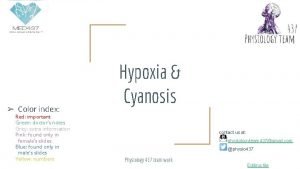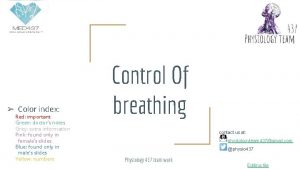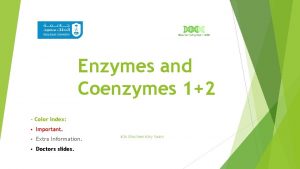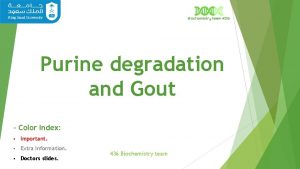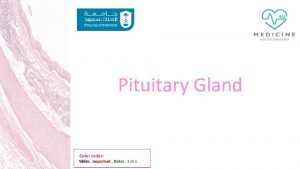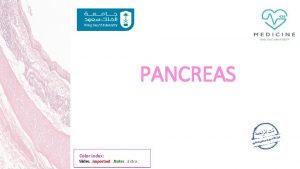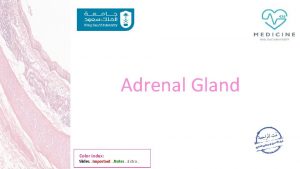Protein structure Color Index Important Extra Information Doctors


























- Slides: 26

Protein structure – Color Index: § Important. § Extra Information. § Doctors slides. 436 Biochemistry team

Objectives By the end of this lecture, the students should be able to: Understand the peptide bonding between amino acids. Explain the different levels of protein structure and the forces stabilizing these structures and what happens when the protein is denatured. Define the α-helix and β-sheet as the most commonly encountered secondary structures in a protein molecule. Correlate the protein structure with function with hemoglobin as an example. Understand how the misfolding of proteins may lead to diseases like Alzheimer’s or prion disease.

What are proteins? They are large, complex molecules Play many critical roles in the body They do most of work in the cell they are made up of hundreds or thousands of smaller units called amino acids which are attached to one another in long chains by a peptide bond. They are required for the structure, function and regulation of the body’s tissues and organs

What are proteins? There are mainly 20 different types of amino acids that can be combined to make a protein. The sequence of amino acids determines : 1 - each protein’s unique threedimensional (3 D) structure 2 - its specific function. Proteins can be described according to their large range of functions in the body: Antibody Enzyme Messenger Structural component Transport/storage

Peptide Bond (amide bond) : Amide linkage that is formed between α-carboxyl group of an amino acid and α-amino group of the other amino acid. Each amino acid (in) a chain makes two peptide bonds. The amino acids (at the two ends) of a chain make only one peptide bond. The amino acid with a free amino group is called amino terminus or NH 2 -terminus. The amino acid with a free carboxylic group is called carboxyl terminus or COOH-terminus. Covalent bond formed by: Removal of water : 1 -OH from COOH 2 -H from NH 3 Group. By : (dehydration)

Peptide bond (amide bond): : ﻣﻼﺣﻈﺔ Residues : amino acid in a peptide chain We always start from N terminus to C terminus

1. Primary structure It is the linear sequence of amino acids in a protein Covalent bonds in the primary structure of protein: 1. Peptide bond **Primary structure proteins are not functional 2. Disulfide bond (if any) (it is not always present) Which is the ”SS bond” , It links two residues of cysteine NEAR TO EACH OTHER as shown in the picture. : ﻣﻼﺣﻈﺔ • Peptide bond are not broken by conditions that denature proteins, such as heat • They can break by prolonged exposure to a strong acid or base at elevated temperatures to hydrolyze (break) these bond or by using enzymes How to determine the primary structure sequence? 1. DNA sequencing. 2. Direct amino acids sequencing.

peptides Amino acids can be polymerized to form chains: Two amino acids dipeptide One peptide bond Three amino acids tripeptide Two peptide bonds tetrapeptide Three peptide bonds Four amino acids Few (2 -20)amino acids oligopeptide More(>20 amino acids) polypeptide

2. Secondary structure • It is regular arrangements of amino acids that are located near to each other in the linear sequence. • Examples of secondary structures frequently found in proteins are: α-helix *It is also not functional β-sheet β-bends • Excluding the conformations (3 D arrangements) of its side chains. *Bonds that are found in it: Hydrogen bonds : ﻣﻼﺣﻈﺔ for the secondary structure , we do not look at the R side chains nor do we look at the hydrophobic interactions that give it its 3 D structure so we exclude that. . We only look at the hydrogen bonds

Secondary structure v α-helix: 1. It is a right-handed spiral 2. side chains of amino acids extended outward. 3. Hydrogen bonds are what Stabilize the α-helix. (Hydrogen bonds form between the peptide bond carbonyl oxygen and amide hydrogen) 4. Amino acids per turn: Each turn contains 3. 6 amino acids. ( ﺣﻤﺾ ﺃﻤﻴﻨﻲ 3. 6 )ﻛﻞ ﻟﻔﺔ ﻓﻴﻬﺎ ﺃﺤﻤﺎﺽ ﻭ ﺍﻟﺮﺍﺑﻌﺔ ﺑﺘﺴﻮﻱ ﺭﺍﺑﻄﺔ 3 ﺍﻷﻮﻟﻰ ﺑﺘﺤﺘﻮﻱ ﻋﻠﻰ ( ﺍﻷﻮﻝ ﻫﻴﺪﺭﻭﺟﻴﻨﻴﺔ ﻣﻊ ﺍﻟﺤﻤﺾ )ﻳﻌﻨﻲ ﺍﻟﻠﻔﺔ

α-helix ﺗﺎﺑﻊ : -Amino acids that disrupt an α-helix: Proline imino group, interferes with the smooth helical structure. ( )ﻷﻨﻪ ﺗﺮﻛﻴﺒﻪ ﻋﻠﻰ ﺷﻜﻞ ﺣﻠﻘﺔ ﻓﺒﻴﺨﺮﺏ ﺍﻟﺸﻜﻞ ﺍﻟﺤﻠﺰﻭﻧﻲ Glutamate, ionic bonds. aspartate, histidine, lysine or arginine form ( these are all polar CHARGED amino acids so they would form ionic bonds thus it would change the shape) Bulky side chain such as tryptophan. ( )ﺣﺠﻤﻪ ﻛﺒﻴﺮ ﻓﺒﻐﻴﺮ ﺍﻟﺸﻜﻞ Branched amino acids at the β-carbon, such as valine or isoleucine. *: ﻟﻠﻔﻬﻢ ﺃﻜﺜﺮ https: //www. youtube. com/watch? v=V 3 Dgr. OG 1 ex. Y

Secondary structure v β-sheet (Composition of a β-sheet) § Two or more polypeptide chains make hydrogen bonding with each other. (beta sheet could be a long polypeptide) (the helix is just one polypeptide chain) § Also called pleated sheets: because they appear as folded structures with edges § Hydrogen bonds: Stabilize the β-sheet. *: ﻟﻠﻔﻬﻢ ﺃﻜﺜﺮ https: //www. youtube. co m/watch? v=koy. E 9 Nplacc

Secondary structure β-sheet (Antiparallel and parallel sheets) Antiparallel: N C C N Parallel: N C Hydrogen bonds in the parallel direction are less stable than in the antiparallel (notice the dotted lines in the picture. . in the antiparallel the lines are straight but in the parallel , they aren’t)

Secondary structure Other secondary structure examples: β-bends (reverse turns): Reverse the direction of a polypeptide chain. Usually found on the surface of the molecule and often include charged residues. The name comes because they often connect successive strands of antiparallel β-sheets. β-bends are generally composed of four amino acid residues, proline or glycine are frequently found in β-bends. Nonrepetitive secondary structure: e. g. loop or coil conformation.

Secondary structure Other secondary structure examples: Supersecondary structures (motifs): A combination of secondary structural elements (that is, α-helices, β-sheets, and coils). These form primarily the core (interior) region of the molecule. They are connected by loop regions. α α motif: two α helices together β α β motif: a helix connects two β sheets β hairpin: reverse turns connect antiparallel β sheets β barrels: rolls of β sheets

Tertiary structure What is it? Domains are • The tertiary structure of a proteins is the functional protein. supersecondary structural elements (motifs) It is the three-dimensional (3 D) structure of an entire polypeptide chain including side chains. • The fundamental functional and 3 D structural units of a polypeptide, >200 amino acids fold into two or more clusters. • The core of a domain is built from combinations of supersecondary structural elements (motifs) and their side chains. a protein with three domains • Domains can be combined to form tertiary structure. The core of a domain Domains When tertiary structure. combined

Interactions stabilizing tertiary structure: Disulfide bonds. a covalent linkage formed from the sulfhydryl group (–SH) of each of two cysteine residues to produce a cystine residue Hydrophobic interactions. Amino acids with nonpolar side chains tend to be located in the interior of the polypeptide molecule, where they associate with other hydrophobic amino acid Hydrogen bonds. Amino acid side chains containing oxygen- or nitrogenbound hydrogen Ionic interactions. Negatively charged groups can interact with positively charged groups such as : carboxylate group (– COO–) in the side chain of aspartate and amino group (– NH 3+)

Tertiary structure Protein folding: Interactions between the side chains of amino acids determine how a long polypeptide chain folds into the intricate threedimensional shape of the functional protein. : ﻟﻠﻔﻬﻢ ﺃﻜﺜﺮ https: //www. youtube. co m/watch? v=QSy. CPD 2 ql. Ps

Tertiary structure Chaperons are a specialized group of proteins, required for the proper folding of many species of proteins. Role of chaperons, also known as “heat chock”, in protein folding: They interact with polypeptide at various stages during the folding process. Examples of chaperons: Hsp 60 and Hsp 70.

Quaternary structure Some proteins contain two or polypeptide chains that may be more structurally identical or ﻳﻌﻨﻲ ﺍﻥ ﻟﻬﺎ ﺷﻜﻞ ﻛﺮﻭﻱ spherical ("globe-like") Each chain forms a 3 D structure called subunit. • Composed of α 2 β 2 subunits (4 subunits). According to the number of subunits: dimeric, trimeric, … or multimeric. • Hemoglobin is a globular protein. • A multisubunit protein is called oligomer ( an oligomer usually refers to a macromolecular complex ) totally unrelated. Hemoglobin (a protomer is the structural unit of an oligomeric protein). Subunits may either function independently of each other, or work • Two same subunits are called protomers. cooperatively, e. g. hemoglobin. Example:

Denaturation of proteins when a protein is denatured, it results in the unfolding and disorganization of the protein’s secondary and tertiary structures. Denaturation agents Heat Organic solvents Mechanical mixing. Strong acids or bases • Most proteins, once denatured, remain permanently disordered. • Denatured proteins are often insoluble and, therefore, precipitate from solution. Detergents Ions of heavy metals (e. g. lead and mercury)

Protein misfolding • Every protein must fold to achieve its normal conformation and function. ﻋﻨﺪ ﺣﺪﻭﺙ ﺧﻠﻞ ﻓﻲ ﺷﻜﻞ ﺍﻟﺒﺮﻭﺗﻴﻦ ﺗﺨﺘﻞ ﻭﻇﻴﻔﺘﻪ ﻟﺬﻟﻚ ﻳﻨﺘﺞ ﻋﻨﻪ ﺍﻣﺮﺍﺽ ﻟﻺﻧﺴﺎﻥ Abnormal folding of proteins leads to a number of diseases in humans. Alzheimer’s disease β amyloid protein is a misfolded protein. Amyloid is aggregates of misfolded proteins outside neurons, it interfere with neurons’ ability of sending massages. It forms fibrous deposits or plaques in the brains of Alzheimer’s patients. Creutzfeldt-Jacob or prion disease Prion protein is present in normal brain tissue , in diseased brains, the same protein is misfolded. It, therefore, forms insoluble fibrous aggregates that damage brain cells.

Take home messages Native conformation of the protein is the functional, fully folded protein structure The unique 3 D structure of the native conformation is determined by its primary structure, i. e. the amino acid sequence Interactions of between the amino acid side chains guide the folding of the polypeptide chain to form secondary, tertiary and sometimes quaternary structures that cooperate in stabilizing the native conformation of the protein. Protein denaturation results in unfolding and disorganization of of the protein’s structure, which are not accompanied by hydrolysis of peptide bonds. Disease can occur when an apparently normal protein assumes a conformation that is cytotoxic, as in the case of Alzheimer disease and Prion disease.

Review

MCQs https: //www. onlineexambuilder. com/bio/exa m-98731 Video: Overview of protein Protein structure

 Carrier vs channel proteins
Carrier vs channel proteins Protein-protein docking
Protein-protein docking Extra information clauses
Extra information clauses Extra information clauses
Extra information clauses Relative clause with extra information
Relative clause with extra information Example of a news story
Example of a news story Inverted pyramid in news writing
Inverted pyramid in news writing Least important to most important
Least important to most important Optical fibre
Optical fibre Primary index is dense or sparse
Primary index is dense or sparse Leprosy
Leprosy Compare india and sri lanka on the basis of hdi
Compare india and sri lanka on the basis of hdi Optical fiber waveguides
Optical fiber waveguides Simpson's diversity index
Simpson's diversity index Plasticity index chart of soil
Plasticity index chart of soil Clustered index và non clustered index
Clustered index và non clustered index James wigg
James wigg Trinity doctors
Trinity doctors Time bound promotion
Time bound promotion Barbara kresal
Barbara kresal California medical license application
California medical license application Heaton moor medical group
Heaton moor medical group Australian curriculum framework for junior doctors
Australian curriculum framework for junior doctors Hse appointed doctors
Hse appointed doctors Mohh residency
Mohh residency World history chapter 6 review
World history chapter 6 review Wood lane medical center
Wood lane medical center




